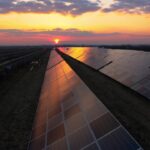Run on Sun is a residential and commercial solar installation company that was founded in 2006 by a group of businessmen, entrepreneurs, and engineers who wanted to leverage their diverse backgrounds to build a better solar company. Run on Sun was founded in part based on a negative experience one of their friends had after deciding to go solar. After selecting a well-known company, they had to wait a full year for their system to be installed, after which point it didn’t work properly. This incident, coupled with the first-hand experience of dealing with salespeople who were either too pushy or were unknowledgeable about the process of going solar, motivated Run on Sun’s CEO Jim Jenal to build a company based on honesty and transparency. The company is committed to not only providing high-quality and long-lasting installations but also educating homeowners about the benefits of solar and being advocates for important policy matters. Jenal authors the company’s blog, Thoughts on Solar, and published the book Commercial Solar: Step by Step which overviews the process of completing a commercial solar system installation from project conception through to completion. Jenal is also actively engaged in policy activism, working with the California Solar Energy Industries Association (CALSEIA) lobbying for solar-friendly bills in California. After over a decade in operation, Run on Sun remains committed to promoting renewable energy by educating their clients and building durable, properly-engineered solar systems that are built to last for decades to come.
Reducing Proposal Generation Time
Run on Sun previously utilized a series of spreadsheets to model projects and generate sales proposals. They utilized one spreadsheet for the product quote, one for the savings analysis, one for the return on investment calculation, and one for cost comparison over time. Each document would then need to be converted into a PDF document and afterward combined to form one single, cohesive proposal. While the end result was undoubtedly very thorough, Jenal notes that it also was very disorganized and time-consuming. Additionally, because each of these steps was done separately and there was no integration with other tools, monthly usage data had to be imported manually and interval data could not be integrated into the project analysis and proposal. Likewise, production data also had to be generated separately and later copied into spreadsheets. The process was cumbersome and disjointed. Jenal estimates that it previously took Run on Sun project developers about 70 minutes to create a complete proposal. However, since adopting Energy Toolbase, and utilizing its seamless integrations with Utility API for interval meter data and Helioscope for production data, it now only takes Run on Sun about 10 to 15 minutes to generate a complete, comprehensive and polished proposal.
Integrating Interval Data
Integrating interval meter data (aka Green Button Data) in project analyses became particularly important for Run on Sun, based in Los Angeles, once Southern California Edison (SCE) switched to mandatory Time-of-Use (TOU) rates as part of the switch to NEM 2.0. Energy Toolbase’s integration with Utility API enables users to directly import interval meter data for several utility territories throughout the U.S., including SCE. Energy Toolbase also accepts Green Button Data from other providers and in different types of file formats. This interoperability with interval meter data enables Energy Toolbase users to perform more rigorous analyses that are highly specific to each customers’ unique project. Green Button Data is particularly important since the implementation of the Net Energy Metering (NEM) version 2.0 in SCE territory. Jenal asserts that Energy Toolbase’s interoperability with interval meter data has gone from “nice to have” to a “must-have.”
“The ability to handle interval data in a meaningful way is very important to us as we try to be as open about how we arrive at a savings estimate as we can be.”
— Jim Jenal, Founder and CEO of Run on Sun

company, often spending time on the roof ensuring his installations meet the
highest standards.
Identifying and Presenting Maximum Savings
Energy Toolbase’s comprehensive utility rate database (with 20,000 unique utility rates across more than 300 territories in all 50 states) has been a great asset to the Run on Sun team. It’s given them the ability to explore different rate structures for specific projects and see how savings are impacted. Run on Sun recently submitted a proposal for what would be the largest project since the company’s inception: a 144 kW solar system for a commercial scrap metal company. Utilizing Energy Toolbase, Run on Sun was able to identify additional savings opportunities by shifting the customers onto different rate structures, post-solar. Leveraging Energy Toolbase’s optimization feature, Run on Sun optimized the system size for return on investment (ROI), which reduced the payback period to 4.6 years. With the Energy Toolbase proposal generation tool, Run on Sun was then able to present these calculations in a clear, compelling, and transparent manner.
Since its founding, Run on Sun has set out to change how people power their lives in Southern California. With a team of highly-trained solar professionals, best-in-class software tools, and an unwavering commitment to transparency and integrity, Run on Sun continues to fulfill its mission every day.

Pasadena, California.




